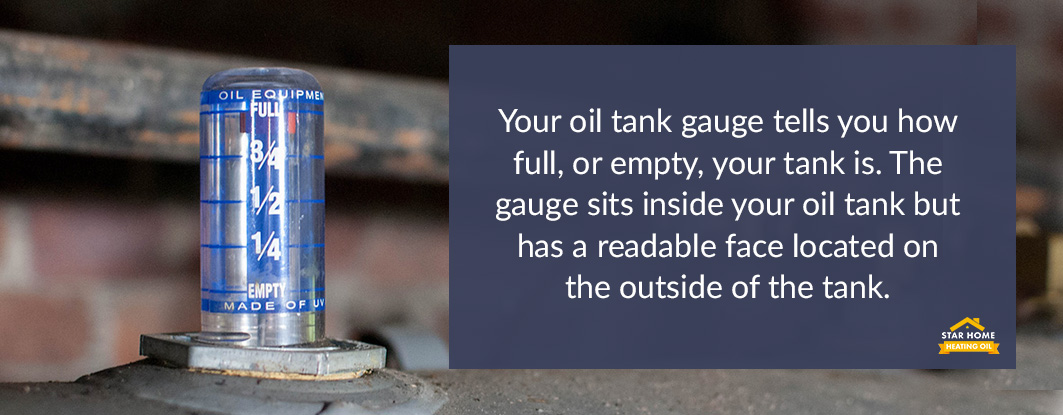How to Fix an Oil Tank Gauge
When it is cold outside, the last thing you want is for your oil tank to run down to empty. Running out of heat or hot water in the cold weather is not only uncomfortable, it can also present dangers to vulnerable family members in our household.
So how do you prevent your tank from running dangerously low on fuel?
The answer is simple – regular monitoring of your oil tank levels. You can do this manually with the use of a gauge stick or you can consult your oil tank gauge.
What Does an Oil Tank Gauge Do?
Your oil tank gauge tells you how full, or empty, your tank is. The gauge sits inside your oil tank but has a readable face located on the outside of the tank.

What some homeowners find to be a bit tricky is the fact that these gauges display the level of oil remaining inside your tank – not the actual number of gallons left inside.
This concept should already be familiar to you. If you think about the inside of your car, you will notice that the oil tank gauge on your dashboard doesn’t show how many gallons remain inside. Rather, it shows you what percentage of your heating oil tank is full or still available. That is exactly how your home heating oil tank gauge works too.
Do Oil Gauges Provide Accurate Readings?
Although your oil gauge can provide a pretty close approximation of your tank’s oil level, the reality is that it is not always accurate. There are several factors that can interfere with your tank gauge’s reading:
- The gauge could simply just malfunction.
- The gauge could become hard to see through due to age or oil buildup on it, and therefore be too difficult to read accurately
- You could have a tank shape that isn’t as conducive to gauge readings. For example, rectangular tank measures more accurately than a rounded one.
- Or, air/extra tank space could account for a portion of the number on your gauge.
As an oil company that has been in business for several decades now, the truth is that we have many oil tank gauges are extremely old and finicky. Why? Simply put, they just aren’t regularly maintenance or replaced the way the rest of the furnace system typically is.
Even though your oil tank gauge is not exact, it is a good starting point for monitoring your oil level and watching for potential leaks.
The Problem with a Broken Oil Tank Gauge
Having a broken oil tank gauge is more than an inconvenience. It can actually become a hazard to your home.
You Risk Running Out of Heating Oil
A faulty or broken tank gauge is not going to do a good job of telling you how long your fuel level is dropping. That puts you at risk of running out of fuel.
Not only do empty tanks put you at risk for frigid temperatures and lack of hot water at home, they also put you at risk for condensation buildup. Condensation can cause bacterial growth, rust or other problems that could impact your tank and heating source.
If you do find yourself in a situation where you are out of fuel due to a broken oil tank gauge, here is what you can do in the meantime until your next oil delivery.
You Could Overfill Your Tank
If you do not know how much oil is in your tank, you risk overfilling it. An overfilled tank leads to heating oil spillage, which is a hazard to your home and the environment.
With that said, your heating oil provider typically does not rely on your tank gauge when filling your tank. Instead, they utilize a tank “whistle” which alerts them to when your tank is just about to be full.
How to Fix a Broken Oil Tank Gauge
If you discover you have a broken oil tank gauge, don’t worry — you can replace it carefully.
To replace a broken oil tank float gauge, you will need:
- A new gauge
- A wrench
- Oil lubricant
- Hooked wire
- Anti-seize
Spray the tank cap with lubricant to loosen it. Turn the cap carefully with a wrench to avoid ruining the threads. Use a flashlight to find the end of the old float gauge arm and pull it from the tank with a piece of wire. Then, remove the gauge from the gauge pipe and place the new gauge inside. Re-insert the gauge and gauge pipe into the oil tank and close the lid.
You might consider using anti-seize on the threads as you do this to ensure a tighter seal. Anti-seize is used to prevent parts from rusting together.
Once you install your new gauge, make sure you inspect it regularly, so it remains operational and easy to read.
Schedule Your Heating Oil Delivery With Star Home Heat
It is so important you inspect your oil tank gauge as regularly as possible. Be sure to replace it as needed too. Never run out of heating fuel again when you schedule a heating oil delivery with Star Home Heat.
We put you in control of your heating oil needs, allowing you to decide when the price is right for you. Simply enter your zip code to see today’s lowest heating oil price in your area. Pick a delivery date, tell us how much fuel you need, and check out securely all within minutes.
Our network of service providers is made up of local companies that meet the highest standards for service, reputability, and reliability. Upon confirmation of your order, your service provider will arrive on schedule! Join Star Home Heat today.


